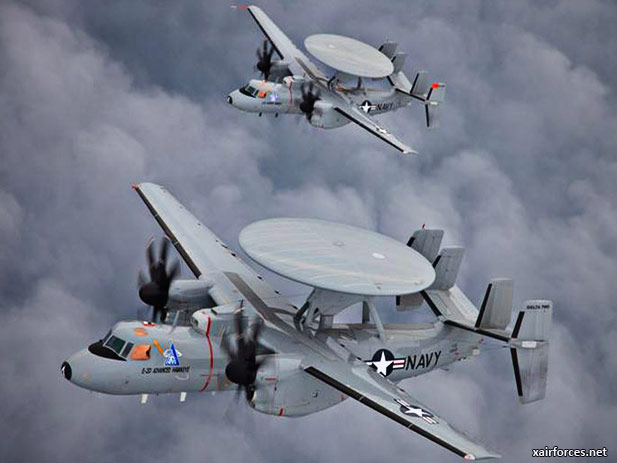
The E-2D Hawkeye Is Overlord of America’s Supercarriers

In the age of super-sonic fighter jets, cruise missiles, and exo-atmospheric ballistic missiles, carrier fleets must be able to monitor as accurately and far afield as possible to avoid being caught unaware of incoming threats.
Odd then, that the duty of watching over the most sophisticated aircraft carriers ever constructed falls to the last propeller-powered planes still allowed to land on them.
The Grumman E-2 Hawkeye is a twin-turboprop aircraft initially designed in the early 1960s as an Airborne Early Warning (AEW) platform. It was built to take over for the outdated E-1 Tracer as an all-weather, carrier-capable aircraft. It measures 57 feet long, 18 feet tall, with an 80-foot wingspan and a distinctive, quad-finned tail assembly. The E-2 is powered by a pair of Rolls-Royce T56 1,500 SHP engines and can reach a maximum speed of 350 knots at a height of 34,700 feet. The plane has a range of 1,605 miles and can remain aloft for about six hours.
Each Hawkeye is commanded by a crew of five: a pilot, co-pilot, combat information center officer, air control officer, and radar operator. The pilot and co-pilot man the helm at the nose of the plane while the other crew members are stationed in the rear fuselage. The radar operator, for example, is tasked with managing the 24-foot rotating dome strapped to the roof of the E-2.
This massive electronic protuberance is the plane's primary long-range radar and IFF antenna. These airborne early warning and control (AEW&C) systems, often seen atop the Boeing E-3 Sentry, are long-range radar units designed to accurately detect and track incoming vehicles (or, offensively, locate strike targets) from hundreds of miles as well as direct the fighter and attack aircraft response—essentially acting as both lookout and air traffic controller.
As Steven Trimble of Flight Global explains,
Northrop has installed a combination of radar systems in a variable speed rotodome. There is a mechanically scanned L-3 Communications Randtron ADS-18 antenna that sweeps in 360e_SDgr for all radio frequency emissions. In addition, the 18-channel Lockheed Martin APY-9 electronically scanned array scans for airborne objects across an arc up to 90e_SDgr wide.
The rotodome is designed to spin at three different speeds, completing a full revolution either every 10s, 12s or 15s. The crew also has the option to stop the rotodome. This allows the radar to focus all the energy provided by the E-2D's twin 170kVa generators, which can each surge to 225kVa for up to 3h, into a targeted area. Concentrating the beam allows the radar to either find smaller targets closer-in, or pick up larger targets at far greater ranges.
It is this unique combination of mechanical and electronic scanning that allows the E-2D to more than double the range of the previous APS-145 radar on the E-2C. Neither Northrop nor navy officials disclose the range of the APY-9, but it is listed as beyond 300nm (555km) and appears only constrained by the distance to the horizon at the E-2D's mission altitude of 25,000ft.
The ability to see to the edge of the world is a definite advantage on the open ocean. They're so valuable that every American Supercarrier group is outfitted with AEW&C aircraft. Not only do they provide early attack warnings, they can perform long-range surveillance, search and rescue, act as over-the-horizon radio relays and even as a flying air traffic control units in disaster recovery operations.
The Hawkeye has been redesigned four times since the original E-2 entered service in 1960. The E-2B and E-2C saw upgrades to their radar and radio communications as the technology advanced. The fourth iteration, the E-2D Advanced Hawkeye, mixes advanced electronic sensors and digital signal processing to see even further. The E-2D enjoys a number of upgrades over its predecessor including completely new radar, advanced IFF systems, a modernized communications and data link suite, and a wicked integrated tactical cockpit.
A pair of E-2D prototypes, dubbed "Delta One" and "Delta Two", just successfully completed its initial operational testing and the model is now cleared for full-rate production, according to Naval Air Systems Command (NAVAIR). The E-2D is expected to enter duty by 2015.
Source: Andrew Tarantola, Gizmodo / Northrup Grumman News - 12 February 2013
Photo: The U.S. Navy Northrop Grumman E-2D Advanced Hawkeye Airborne Early Warning (AEW) platform (Photo by Northrop Grumman Corp.)
(12.02.2013)
|